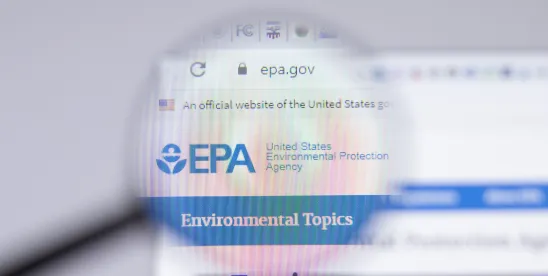Under the Biden administration, the U.S. Environmental Protection Agency (EPA) dealt two substantial blows to efforts to turn waste plastics into useful products through advanced recycling techniques such as pyrolysis. Now, the Trump EPA has the opportunity to change direction. EPA has taken a first step under the Toxic Substances Control Act (TSCA), but it has also declined to take a step forward under the Clean Air Act (CAA). Meanwhile, an increasing number of states are removing a roadblock to advanced recycling by declaring it manufacturing rather than waste disposal.
The Toxic Substances Control Act
The Roadblock – Risks of Potential Contaminants
The chemical composition of waste plastics changes when exposed to high heat in the absence of oxygen. The resulting pyrolysis products are typically considered to be new chemical substances. Companies have submitted numerous premanufacture notices (PMNs) to EPA for products named “plastics, wastes, pyrolyzed, [additional description],” or with similar names. EPA has issued fairly routine orders under section 5(e) for these PMN substances. It adopted corresponding significant new use rules (SNURs) for them as well. Examples include 40 C.F.R. §§ 721.10937 through 721.10939. For the corresponding PMNs, P-14-0712 through -0715 (submitted by an undisclosed company), the 2016 section 5(e) order requires testing the substances for dioxin and furan impurities every quarter. No other section 5(e) orders for the products of advanced recycling require testing.
In April 2023, the Biden EPA published a Draft National Strategy to Prevent Plastic Pollution. It announced a new policy on PMNs for products made from waste plastics converted by pyrolysis:
“EPA is aware of concerns about the potential health and environmental risks posed by impurities that may be present in pyrolysis oils generated from plastic waste. Accordingly, EPA intends to require companies submitting new pyrolysis oil chemicals to the Agency for review under TSCA to conduct testing for impurities that could be present in the new chemical substance prior to approval, and ongoing testing to ensure there is no variability in the plastic waste stream that is used to generate the pyrolysis oil.”
Since the feedstock of waste plastics can be variable, such significant testing obligations could pose substantial obstacles to pyrolysis-based advanced recycling.
In June 2023, EPA followed up with proposed SNURs for 18 PMN substances derived from waste plastics that had been pyrolyzed (P-21-0144 through -0150, 0152-0158, and -0160-0163, submitted by Chevron, U.S.A.). Their 2022 section 5(e) order had no provisions relating to contaminants. However, the proposed SNURs would identify as an additional significant new use the manufacturing or processing of the chemical substances using feedstocks that contain any amount of heavy metals (arsenic, cadmium, chromium VI, lead, mercury), dioxins, phthalates, PFAS, polybrominated diphenyl ethers, alkylphenols, perchlorates, benzophenone, bisphenol A, organochlorine pesticides, ethyl glycol, methyl glycol, or N-methyl-2-pyrrolidone. The 2023 announcement and proposed SNURs largely brought a halt to the filing of new PMNs for the products derived from pyrolyzed waste plastics.
Subsequent litigation challenged the section 5(e) orders for the 18 PMN substances. Cherokee Concerned Citizens v. EPA, No. 23-1096 (D.C. Cir.). The amicus brief by the Environmental Defense Fund argued that the orders were arbitrary because they did not consider the risks of “toxic contaminants such as PFAS, heavy metals (including arsenic, lead, and mercury), phthalates, flame retardants, and dioxins.” The litigation led the Biden EPA to announce that it would withdraw, which it did on December 18, 2024.
These 18 PMNs are not the only instances since 2023 when the issue of toxic contaminants in waste plastic pyrolysis products has arisen. In June 2022, Braven Environmental, LLC filed three significant new use notices (SNUNs) for various fractions of waste plastics, pyrolyzed, SN-22-0007, -0008, and -0009. Those SNUNs relate to 40 C.F.R. §§ 721.10938 through 721.10940. In September 2023 and February 2024, EDF and Earthjustice submitted comments (see here, here, and here), citing the same concerns as above regarding health and environmental concerns from contaminants in pyrolysis oils produced with feedstocks containing a wide range of such contaminants. After three years, EPA still has not taken action on those SNUNs, although Braven has submitted additional information.
In January 2025, Motiva Enterprises, LLC submitted PMNs for 17 new chemicals with generic names such as “hydrocarbons, processed” (P-25-0041 through -0057). In March, Earthjustice and Community In-Power and Development Association filed comments in response to these PMNs. The comments asserted: “It is unclear whether the PMNs are connected to that pygas production, but many pyrolysis feedstocks, such as plastic waste, contain harmful chemicals that can contaminate pyrolysis oil. As EPA has previously acknowledged, pyrolysis oils derived from the burning of plastic waste may ‘contain impurities like per- and polyfluoroalkyl substances (PFAS), heavy metals, dioxins, bisphenols[,] and flame retardants. . . [that] are known to cause cancer and harm the reproductive system, among other health effects.’” EPA has taken no action on those PMNs, despite Motiva’s submission of additional information.
Opportunities for the Trump EPA
On July 9, 2025, the Trump EPA announced its withdrawal of the 18 proposed SNURs (90 Fed. Reg. 30216). It cited its earlier withdrawal of the section 5(e) orders and the adverse comments it had received on the proposed SNURs (NGO comments had supported the proposed SNURs). With this procedural action, EPA has set the stage for changing the Biden EPA’s policy on pyrolysis products from waste plastics, but it has not yet done so.
EPA has not yet issued new section 5(e) orders for the Chevron PMNs. It has not acted on the Braven SNUNs. It has not issued section 5(e) orders for the Motiva PMNs. In each of those cases, it has the opportunity to set a different direction for regulating advanced recycling under TSCA. The advanced recycling industry, as well as some NGOs, await action by the Trump EPA with interest.
The Clean Air Act
The Roadblock – Treating Pyrolysis as Incineration
The Clean Air Act (CAA) provides another arena of uncertainty for the advanced recycling industry. The issue of whether pyrolysis-based advanced recycling is subject to EPA’s New Source Performance Standards (NSPS) under CAA section 129.
In 2005, EPA declared that “pyrolysis/combustion units (two chamber incinerators with a starved air primary chamber followed by an afterburner to complete combustion) within the VSMWC and IWI subcategories are considered OSWI units.” This position appeared to confirm that pyrolysis of waste plastics is subject to the NSPS.
In 2020, with the rise of advanced recycling, the Trump EPA published a proposed rule to modify the other solid waste incineration (OSWI) definition of “municipal waste combustion unit” to make it clear that pyrolysis/combustion units are not OSWIs (and thus are thus are not subject to section 129 requirements) “because such units are used to combust uncontained gases and do not involve the combustion of solid waste as defined in the OSWI rule.”
In 2021, the Biden EPA published an advanced notice of proposed rulemaking to gather more details on pyrolysis/combustion units. In response to significant adverse comments, in 2023, EPA withdrew the proposed revisions to the definition of “municipal waste combustion unit.” In effect, this left the 2005 interpretation in place.
Opportunity for the Trump EPA
In June 2025, the Trump EPA finalized its periodic review of the emissions standards and other requirements for OSWI units in the OSWI New Source Performance Standards. This presented an opportunity for the Trump EPA to revise the position on pyrolysis units being subject to the NSPS. However, EPA passed on the opportunity. Instead, after reviewing the history of the issue, it chose to leave the current situation unchanged, stating, “Accordingly, the EPA will not be taking additional action related to pyrolysis/combustion units in this action.”
Whether the Trump EPA will find another opportunity to revisit this issue is unclear.
State Regulation of Pyrolysis of Waste Plastics
The Roadblock – Waste Plastics Pyrolysis as Waste Disposal
An advanced recycling issue analogous to the CAA Section 129 issue is the state treatment of the pyrolysis of waste plastics. If a state classifies pyrolysis as a form of waste disposal, it is subject to the state’s solid waste disposal requirements. Those requirements would impose a substantial burden on advanced recycling.
To date, three states – Maine, New Jersey, and New Mexico – have enacted statutes or regulations declaring the pyrolysis of waste plastics a form of solid waste disposal. For example, the Maine statute defines “solid waste processing facility” to include “a facility that processes plastic waste through chemical plastic processing,” where “chemical plastics processing” is defined to mean “the processing of plastic waste using chemical or molecular methods into basic raw materials, feedstock chemicals, fuel for combustion, waxes or lubricants.”
Waste Plastics Pyrolysis as Manufacturing
In contrast, 27 states have designated advanced recycling as a form of manufacturing, exempting it from solid waste disposal requirements. For example, the Texas statute provides, “‘Advanced recycling facility’ means a manufacturing facility that receives, stores, and converts post-use polymers and recoverable feedstocks using advanced recycling technologies and processes including pyrolysis, gasification, solvolysis, and depolymerization. For purposes of this chapter and rules adopted by the commission under this chapter, an advanced recycling facility is not a solid waste facility, final disposal facility, waste-to-energy facility, or incinerator.”
The remaining 20 states have not taken a formal position on this issue. Some are considering legislation that would declare advanced recycling techniques to be manufacturing rather than waste disposal.
Click here to view a listing of the positions taken by all 50 states on this issue.
Chloe Heller contributed to this article





 />i
/>i

